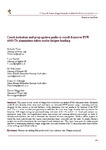Crack initiation and propagation paths in small diameter FSW 6082-T6 aluminium tubes under fatigue loading
| dc.contributor.author | Tovo, R | en |
| dc.contributor.author | Susmel, L | en |
| dc.contributor.author | James, MN | en |
| dc.contributor.author | Hattingh, DG | en |
| dc.contributor.author | Maggiolini, E | en |
| dc.date.accessioned | 2018-01-09T10:21:03Z | |
| dc.date.available | 2018-01-09T10:21:03Z | |
| dc.date.issued | 2016-04-01 | en |
| dc.identifier.uri | http://hdl.handle.net/10026.1/10511 | |
| dc.description.abstract |
This paper reports results of fatigue tests of friction stir welded (FSW) aluminium tubes. Relatively small 38 mm diameter tubes were used and hence an automated FSW process using a retracting tool was designed for this project, as the wall thickness of the aluminium tube was similar to the diameter of the FSW tool. This is a more complex joint geometry to weld than the more usual larger diameter tube reported in the literature. S-N fatigue testing was performed using load ratios of R = 0.1 and R = -1. Crack path analysis was performed using both low magnification stereo microscopy and scanning electron microscopy, in order to identify crack initiation sites and to determine the direction of crack propagation. Work is still in progress to follow the crack path through the various microstructural zones associated with the weld. A simple statistical analysis was used to characterize the most typical crack initiation site. This work forms part of a wider project directed at determining multiaxial fatigue design rules for small diameter 6082-T6 aluminium tubes that could be of use in the ground vehicle industry. | en |
| dc.format.extent | 119 - 129 | en |
| dc.language.iso | en | en |
| dc.title | Crack initiation and propagation paths in small diameter FSW 6082-T6 aluminium tubes under fatigue loading | en |
| dc.type | Journal Article | |
| plymouth.issue | 36 | en |
| plymouth.volume | 10 | en |
| plymouth.publication-status | Published | en |
| plymouth.journal | Frattura ed Integrita Strutturale | en |
| dc.identifier.doi | 10.3221/igf-esis.36.12 | en |
| plymouth.organisational-group | /Plymouth | |
| plymouth.organisational-group | /Plymouth/Faculty of Science and Engineering | |
| plymouth.organisational-group | /Plymouth/Faculty of Science and Engineering/School of Engineering, Computing and Mathematics | |
| plymouth.organisational-group | /Plymouth/Users by role | |
| plymouth.organisational-group | /Plymouth/Users by role/Academics | |
| dc.identifier.eissn | 1971-8993 | en |
| dc.rights.embargoperiod | Not known | en |
| rioxxterms.versionofrecord | 10.3221/igf-esis.36.12 | en |
| rioxxterms.licenseref.uri | http://www.rioxx.net/licenses/all-rights-reserved | en |
| rioxxterms.type | Journal Article/Review | en |


